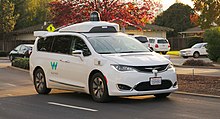Mobil otonom

Mobil otonom (juga dikenal sebagai mobil tanpa pengemudi, mobil tanpa sopir, mobil berkemudi sendiri, mobil robotik[1]) dan kendaraan darat tanpa awak adalah sebuah kendaraan yang dapat menjelajahi lingkungannya dan bergerak tanpa penggerakan dari manusia.[2]
Mobil-mobil otonom memakai berbagai teknik untuk mendeteksi hal-hal di sekitarnya, seperti radar, sinar laser, GPS, odometri dan penglihatan komputer. Sistem kontrol yang maju memakai informasi sensori untuk mengidentifikasikan wadah-wadah navigasi yang semestinya, serta rintangan-rintangan dan tanda jalan.[3][4] Mobil-mobil otonom harus memiliki sistem kontrol yang dapat menganalisis data sensori untuk membedakan antar mobil yang berbeda di jalan.[5]
Referensi
- ^ Thrun, Sebastian (2010). "Toward Robotic Cars". Communications of the ACM. 53 (4): 99–106. doi:10.1145/1721654.1721679.
- ^ Gehrig, Stefan K.; Stein, Fridtjof J. (1999). Dead reckoning and cartography using stereo vision for an autonomous car. IEEE/RSJ International Conference on Intelligent Robots and Systems. 3. Kyongju. hlm. 1507–1512. doi:10.1109/IROS.1999.811692. ISBN 0-7803-5184-3.
- ^ Lassa, Todd (January 2013). "The Beginning of the End of Driving". Motor Trend. Diarsipkan dari versi asli tanggal 2014-08-17. Diakses tanggal 1 September 2014.
- ^ European Roadmap Smart Systems for Automated Driving Diarsipkan 2015-02-12 di Wayback Machine., European Technology Platform on Smart Systems Integration (EPoSS), 2015.
- ^ Zhu, Wentao; Miao, Jun; Hu, Jiangbi; Qing, Laiyun (2014-03-27). "Vehicle detection in driving simulation using extreme learning machine". Neurocomputing. 128: 160–165. doi:10.1016/j.neucom.2013.05.052.
Bacaan tambahan
- O'Toole, Randal (18 January 2010). Gridlock: Why We're Stuck in Traffic and What To Do About It. Cato Institute. ISBN 978-1-935308-24-9.
- Macdonald, Iain David Graham (2011). A Simulated Autonomous Car (PDF) (thesis). The University of Edinburgh. Diakses tanggal 17 April 2013.
- Knight, Will (2013-10-22). "The Future of Self-driving Cars". MIT Technology Review. Diakses tanggal 2016-07-22.
- Glancy, Dorothy (2016). A Look at the Legal Environment for Driverless Vehicles (PDF) (Laporan). National Cooperative Highway Research Program Legal Research Digest. 69. Washington, DC: Transportation Research Board. ISBN 978-0-309-37501-6. Diakses tanggal 2016-07-22.
- Meyer, Gereon; Beiker, Sven, ed. (2014). Road vehicle automation. Springer. ISBN 978-3-319-05990-7.
- Meyer, Gereon; Beiker, Sven, ed. (2015). Road vehicle automation 2. Springer. ISBN 978-3-319-19078-5.
- Newbold, Richard (2015-06-17). "The driving forces behind what would be the next revolution in the haulage sector". The Loadstar. Diakses tanggal 2016-07-22.
- Bergen, Mark (2015-10-27). "Meet the Companies Building Self-Driving Cars for Google and Tesla (And Maybe Apple)". re/code.
- John A. Volpe National Transportation Systems Center (March 2016). "Review of Federal Motor Vehicle Safety Standards (FMVSS) for Automated Vehicles: Identifying potential barriers and challenges for the certification of automated vehicles using existing FMVSS" (PDF). National Transportation Library. U.S. Department of Transportation. Diarsipkan dari versi asli (PDF) tanggal 2017-06-16. Diakses tanggal 2017-12-27.
- Slone, Sean (August 2016). "State Laws on Autonomous Vehicles" (PDF). Capitol Research - Transportation Policy. Council of State Governments. Diarsipkan dari versi asli (PDF) tanggal 2021-02-28. Diakses tanggal 2016-09-28.
- Steve Henn (31 July 2015). "Remembering When Driverless Elevators Drew Skepticism".
- James M. Anderson et. al. (2016). "Autonomous Vehicle Technology: A Guide for Policymakers" (PDF). RAND Corporation.










